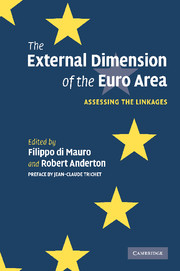Book contents
- Frontmatter
- Contents
- List of illustrations
- List of contributors
- Preface by Jean-Claude Trichet
- 1 Introduction
- 2 The external dimension of the euro area: stylised facts and initial findings
- 3 Product variety and macro trade models: implications for the new EU Member States
- 4 Exchange-rate pass-through to import prices in the euro area
- 5 The international equity holdings of euro area investors
- 6 Global linkages through foreign direct investment
- 7 Shocks and shock absorbers: the international propagation of equity market shocks and the design of appropriate policy responses
- 8 The euro area in the global economy: its sensitivity to the international environment and its influence on global economic developments
- Index
- References
3 - Product variety and macro trade models: implications for the new EU Member States
Published online by Cambridge University Press: 22 September 2009
- Frontmatter
- Contents
- List of illustrations
- List of contributors
- Preface by Jean-Claude Trichet
- 1 Introduction
- 2 The external dimension of the euro area: stylised facts and initial findings
- 3 Product variety and macro trade models: implications for the new EU Member States
- 4 Exchange-rate pass-through to import prices in the euro area
- 5 The international equity holdings of euro area investors
- 6 Global linkages through foreign direct investment
- 7 Shocks and shock absorbers: the international propagation of equity market shocks and the design of appropriate policy responses
- 8 The euro area in the global economy: its sensitivity to the international environment and its influence on global economic developments
- Index
- References
Summary
Introduction
Standard trade equations in multi-country macroeconomic models imply that rapidly-growing countries should have either declining trade balances or declining terms of trade. In long-run equilibrium, intertemporal budget constraints prevent trade balances from declining indefinitely. Hence, for countries that are expected to grow faster than their trading partners for an extended period of time, standard models imply that the terms of trade should decline secularly.
The new EU Member States (NEUMS) to the European Union (EU) are expected to grow faster than the fifteen pre-2004 EU countries (EU-15) for the foreseeable future. Given that the overwhelming majority of NEUMS trade occurs within the EU, standard macroeconomic models imply that NEUMS export prices should decline relative to NEUMS import prices. This conclusion has a potentially important implication for NEUMS monetary policy. A fixed exchange rate with other EU countries might be expected to have a deflationary effect on NEUMS economies – yet six of the NEUMS have already joined the Exchange Rate Mechanism linking them (plus Denmark) to the euro, albeit with fairly wide bands. All of the NEUMS have expressed their intention to join the euro area by the end of the decade.
Will exchange-rate links to the euro doom the NEUMS to persistent export price deflation, with possible harmful consequences for macroeconomic outcomes? This chapter argues that the answer is ‘no’ because the standard macroeconomic models have a serious misspecification of the trade sector.
- Type
- Chapter
- Information
- The External Dimension of the Euro AreaAssessing the Linkages, pp. 52 - 62Publisher: Cambridge University PressPrint publication year: 2007



